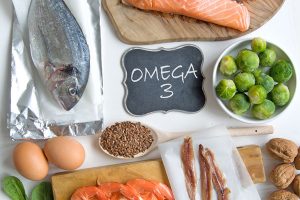
By Irene Wohlfahrt, MSc
Omega-3 fatty acids and their health benefits have received much attention during recent years. Either animal- or plant-derived, supplements containing these unsaturated fats are soaring in most markets. The ingredient has been described as being capable of doing anything except start your car in the morning, and new health benefits are still being discovered.
Did you know you can request omega-3 ingredient samples?
Prospector members can request ingredient samples from global suppliers, plus find technical data, ordering information and more.
Sources of omega-3 fatty acids
Typical dietary omega-3 fatty acids are alpha-linolenic acid (ALA), eicosapentaenoic acid (EPA) and docosahexaenoic acid (DHA). The human body cannot manufacture ALA but once consumed, it is converted into EPA and DHA. Prominent sources for omega-3 fatty acids include:
- flaxseed oil
- fish oil
- chia seeds
- walnuts
- fish roe (eggs)
- fatty fish
- seafood
- soybeans
- spinach
EU omega-3 health claims
In the EU, according to Commission Regulation (EU) No 432/2012, several health claims have been approved for the omega-3 fatty acids DHA and EPA, such as:
- Maintenance of normal:
- brain function (DHA)
- vision (DHA)
- cardiac function (DHA/EPA)
- blood concentrations of triglycerides (EPA; DHA; EHA/DHA)
- blood pressure (EHA/DHA)
Commission Regulation (EU) No 440/2011 on health claims made on foods and referring to children’s development and health allows claims like
- Maternal intake of DHA ‘contributes to the normal brain development of the fetus and breastfed infants’
- Maternal intake of DHA ‘contributes to the normal development of the eye of the fetus and breastfed infants’
- DHA intake contributes to the normal visual development of infants up to 12 months of age.
Benefits of omega-3 supplements
Joint health, eye health, prevention of cognitive decline, and also skin conditions including psoriasis are among the benefits of omega-3 supplementation. Taken during pregnancy, omega-3 can even reduce perinatal depression, and reduces the tendency of developing asthma in children.
Clearly a highly beneficial ingredient, which is why the market for it is soaring. However, merely increasing intake of omega-3 fatty acids may not be enough.
The need for omega-6 fatty acids
Another important part of our diet, as far as unsaturated fatty acids are concerned, is the omega-6 family. These fats are important for brain function, and just like omega-3 fatty acids, our bodies are unable to synthesize them, so we have to take them up with our diet.
Humans as a species have evolved taking up omega-3 and omega-6 fatty acids at a ratio of about 1:1. During the last 100 years or so, however, our diet has changed substantially, increasing the amount of omega-6 fatty acids more than tenfold. This means that today, the ratio of uptake for omega-3 and omega-6 is in excess of 1:10, or in some cases as high as 1:30.
The shifted ratio and concomitant oversupply of omega-6 has given rise to a number of health problems, since it induces a pro-inflammatory state in the human body, in part because omega-6 and omega-3 fatty acids compete for the same rate-limiting enzymes.
A high proportion of omega-6 to omega-3 fat in the diet shifts the physiological state in the tissues toward the pathogenesis of many diseases due to their prothrombotic, proinflammatory and proconstrictive potential. This state, in turn, leads to the development of a number of diseases including cardiovascular disease, autoimmune diseases, rheumatoid arthritis, asthma, and even several kinds cancer.
In order to reach the "natural" ratio of 1:1 for these two different kinds of unsaturated fats, it is not sufficient to just increase the uptake of omega-3 fatty acids. Omega-6 uptake should be lowered at the same time in order to receive the full benefit of omega-3 supplementation, and to reduce the detrimental effects of omega- 6 oversupply.
Omega-6 fatty acids naturally occur in a number of vegetable oils such as:
- grape seed oil
- evening primrose oil
- borage oil
- blackcurrant seed oil
- flax/linseed oil
- rapeseed or canola oil
- hemp oil
- soybean oil
- cottonseed oil
- sunflower seed oil
- corn oil
- safflower oil
- pumpkin seeds
They are also contained in grain products such as whole-grain breads and cereals as well as in poultry, eggs, and nuts.
However, simply avoiding these foods may not solve the problem. A study revealed that cattle feeding systems had a great effect on nutrient content on the meat sold to consumers. Cynthia Doyle conducted an experiment to observe the fatty acid content of beef raised through grass feeding versus grain feeding; she concluded that grass-fed animals contain an overall omega-6:omega-3 ratio that is preferred by nutritionists (Doyle et al, 2010)1.
Grain-feeding cattle is a way to increase their weight and prepare them for slaughter much quicker compared to grass-feeding. This modern way of feeding animals may be one of many reasons why the omega-6:omega-3 ratio has increased.
This is a great opportunity for new product developers (NPD) and food business operators in general. Together with educating consumers about the issue as far as regulations allow, here are some additional opportunities:
- Formulate products, e.g. ready-to-eat meals, whose omega-3:omega-6 ratio is as close to 1:1 as possible.
- Plant oils could be enriched with omega-3 to achieve a better ratio
- Other bases, such as salad sauces and freeze-dried ready meals, could also be adjusted.
In fact, a lot of options exist in this area, for ingredient developers and end product producers alike.
References:
- Doyle, Cynthia; Abbott, Amber; Doyle, Patrick; Nader, Glenn; Larson, Stephanie (2010). "A review of fatty acid profiles and antioxidant content in grass-fed and grain- fed beef". Nutrition Journal. 9 (1): 10.
- Commission Regulation (EU) No 432/2012 of 16 May 2012 establishing a list of permitted health claims made on foods, other than those referring to the reduction of disease risk and to children’s development and health (Update April 4, 2017)
- Commission Regulation (EU) No 440/2011 of 6 May 2011 on the authorisation and refusal of authorisation of certain health claims made on foods and referring to children’s development and health
You may also be interested in:
- Tricalcium Phosphate for Food Formulations
- Heavyweight Product Development Match-Up: MRP or Protein Powder?
- High-Oleic Oils: Are They as Slick as They Sound?
About the Author
 Irene Wohlfahrt MSc is a Senior Consultant with analyze & realize GmbH (a&r), a leading clinical research organization (CRO) and a consulting company specialized in natural health products and herbal medicines. Irene is a trained biologist with a focus on animal physiology and biochemistry. She joined a&r in 2004 and contributed to several departments of the company before becoming a team member of the Consulting and Strategic Innovation team. Her expertise is regulatory affairs in food supplements and FSMPs as well as product development and innovation. She is also a regulator contributor to various trade journals.
Irene Wohlfahrt MSc is a Senior Consultant with analyze & realize GmbH (a&r), a leading clinical research organization (CRO) and a consulting company specialized in natural health products and herbal medicines. Irene is a trained biologist with a focus on animal physiology and biochemistry. She joined a&r in 2004 and contributed to several departments of the company before becoming a team member of the Consulting and Strategic Innovation team. Her expertise is regulatory affairs in food supplements and FSMPs as well as product development and innovation. She is also a regulator contributor to various trade journals.
The views, opinions and technical analyses presented here are those of the author or advertiser, and are not necessarily those of ULProspector.com or UL Solutions. The appearance of this content in the UL Prospector Knowledge Center does not constitute an endorsement by UL Solutions or its affiliates.
All content is subject to copyright and may not be reproduced without prior authorization from UL Solutions or the content author.
The content has been made available for informational and educational purposes only. While the editors of this site may verify the accuracy of its content from time to time, we assume no responsibility for errors made by the author, editorial staff or any other contributor.
UL Solutions does not make any representations or warranties with respect to the accuracy, applicability, fitness or completeness of the content. UL Solutions does not warrant the performance, effectiveness or applicability of sites listed or linked to in any content.



My dad is planning to try the Omega-3 supplement because he heard that this may help ease depression. Well, it never occurred to me that it contains flaxseed oil and chia seeds. It’s also interesting to learn that this type of supplement is beneficial in terms of maintaining blood pressure.